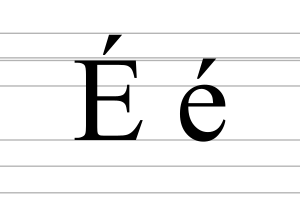É facts for kids
The letter É or é is a special letter that you don't usually see in the English language. It's the letter E with a small mark called an acute accent above it.
You can find É in many languages around the world, like French, Spanish, Portuguese, and Hungarian. In English, you might see it in words that came from other languages, like résumé (which means a summary of your work history) or cliché (a phrase that's been used too much). It's also in names like Pokémon.
Contents
How É Is Used in Different Languages
Czech and Slovak
É is the 9th letter in the Czech alphabet and the Slovak alphabet. In these languages, it makes a long "eh" sound, like the "ay" in "say".
Danish, Norwegian, and Swedish
In Danish, Norwegian, and Swedish, É is used to show that the letter E should be stressed or emphasized when you say a word. It can even change the meaning of a word!
Dutch
You'll find É in Dutch words that come from other languages, especially French. It also helps tell the difference between two similar words:
- "een" means "a" or "an".
- "één" means the number one.
The accent adds stress, much like when you make a word italic in English to emphasize it. Sometimes, Dutch speakers use "hé" to say "hey" or "hi".
Emilian-Romagnol
In the Emilian language, É makes an "e" sound, like in the word récc, which means "rich". In the Romagnol language, É makes a longer "e" sound, like in lédar, meaning "thieves".
English
In English, É mostly appears in words borrowed from French. Some examples include:
- née (used to show a woman's birth name)
- résumé (a document for job applications)
- fiancée (a woman who is engaged to be married)
- sauté (a cooking method)
- coupé (a type of car)
You also see É in some names, like Beyoncé or JonBenét.
French
The letter É is very common in French. It makes a clear "ay" sound, like the "e" in "café". Another French letter, È (E with a grave accent), makes a slightly different "eh" sound, like the "e" in "bed". Even though they look similar, they are different letters with different sounds.
Hungarian
É is the 9th letter of the Hungarian alphabet. In Hungarian, it makes a long "ay" sound, similar to the "a" in "father" but with an "e" sound.
Icelandic
É is the 7th letter of the Icelandic alphabet. In Icelandic, it makes a "yeh" sound.
Irish
In Irish, an acute accent over a vowel means you should say that vowel for a longer time. So, É makes a long "ay" sound.
Italian
In Italian, É makes an "e" sound and shows where the stress is in a word. It's usually found at the very end of a word. For example, perché means "why" or "because". Sometimes, the accent helps tell words apart that are spelled the same but have different meanings, like pésca (meaning "fishing"). Italian also has the letter È (E with a grave accent), which makes a slightly different "eh" sound.
Kashubian
É is the 8th letter of the Kashubian alphabet. In Kashubian, it makes an "eh" sound, like the "e" in "bed".
Portuguese
In Portuguese, É is used to show that an "eh" sound is stressed, especially when the stress isn't obvious. For example, péssimo means "very bad". É can also mean the word "is," as in ela é bonita ("she is pretty"). Portuguese also uses Ê (E with a circumflex), which makes a different "ay" sound.
Spanish
In Spanish, the letter É sounds the same as a regular E. The accent mark simply shows which part of the word should be stressed when you say it. This is helpful for words that don't follow the usual stress rules, like éxtasis or bebé.
Scottish Gaelic
The letter É used to be in the Scottish Gaelic alphabet. However, it has now been replaced by the letter È, which is an E with a grave accent.
Welsh
In Welsh, É is used to put stress on a short vowel. This means you say that vowel quickly but with emphasis. Examples include:
Vietnamese
In Vietnamese, the letter É shows a rising tone. This means your voice goes up when you say the word. É can also be combined with a circumflex to create the letter "Ế".
How to Type É
On Keyboards
- If you use Microsoft Windows, you can type a small é by holding down the Alt key and typing 130 or 0233 on the numeric pad. For a big É, hold Alt and type 144 or 0201.
- On US international and UK English keyboards, you can type É by pressing AltGr and E at the same time. This trick works for other letters with acute accents too!
- In Microsoft Word, you can type é by pressing Ctrl and ' (apostrophe) at the same time, then pressing E. For a big É, press Shift and E after Ctrl+'.
- On macOS, type é by pressing ⌥ Option and E at the same time, then pressing E. For a big É, press Shift and E after ⌥ Option+E.
- If your keyboard has a compose key, you can hold Compose, then press ' (apostrophe), then E for é. For a big É, hold Compose, then press ' (apostrophe), then Shift, then E.
- On a standard Android, Windows Mobile, or iOS keyboard (like on a phone or tablet), just hold down the E key. A small menu of different E letters will pop up. Slide your finger to the é and then let go.
See also
In Spanish: É para niños


